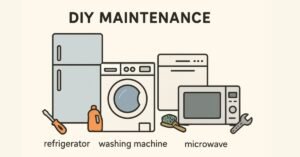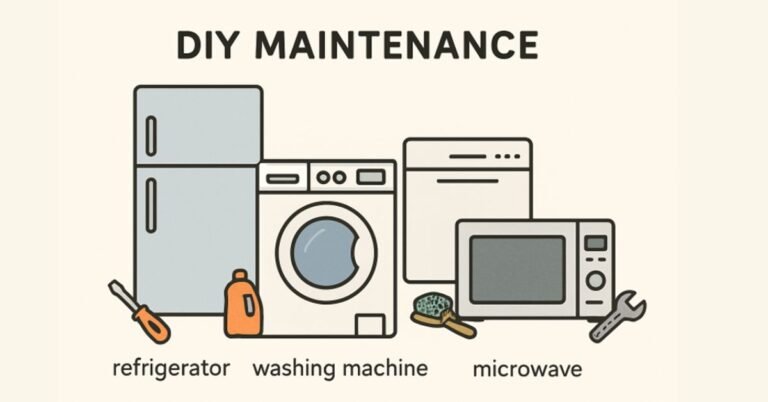Every home relies on appliances to make life easier, but when something goes wrong, even the smallest malfunction can be a major headache. Fortunately, not all appliance breakdowns require an expensive service call. With the right know-how and a few creative solutions, you can troubleshoot and fix many common problems yourself—keeping your household running smoothly and saving money. From fixing leaky dishwashers to tackling washing machine odors, even older appliances can often be revived with a spare part or some clever DIY efforts. For replacement parts or upgrades, check out Samsungparts.com for genuine options and resources. Equipping yourself with a bit of maintenance knowledge goes a long way, and addressing small issues early can keep your appliances working better, longer. Not only does this prevent frustrating breakdowns, but it also helps you avoid bigger repair bills and appliance replacements in the future. The solutions below will help with some of the most common kitchen and laundry appliance woes, with easy-to-follow strategies that even beginners can implement. Creating a regular maintenance routine not only ensures your home runs efficiently, but it can also foster a safer environment—reducing the risks of water damage, fire hazards, or food spoilage. Whether you’re dealing with sudden leaks, a fridge not keeping cool, or a vacuum that’s lost its power, being proactive pays off.
Read on for solutions to your most persistent appliance problems, and don’t forget that timely upkeep can vastly extend the lifespan and efficiency of your favorite household helpers.
Refrigerator Not Cooling
A refrigerator that isn’t keeping food cold can quickly lead to spoiled groceries and inconvenience. One of the easiest and most effective solutions is to clean the condenser coils, as accumulated dust and debris can seriously hinder the appliance’s ability to cool. To do this, unplug your refrigerator and locate the coils (typically at the back or underneath). Use a specialty coil brush or your vacuum’s brush attachment to gently clear away buildup. Repeating this process every six months can keep your fridge in peak condition.
Sometimes blocked air vents or overloaded storage can also reduce efficiency. Maintain space between stored items to allow airflow and avoid crowding, especially near the back wall, where cold air circulates the most. For more guidance on refrigerator maintenance, check this resource from Realtor.com.
Dishwasher Leaks
Leaky dishwashers are a common source of water damage in kitchens. One of the first DIY checks should be the door gasket—if it’s cracked, worn, or loose, it may need replacement. Gently clean around the seal and check for visible gaps or breaks. If the seal is intact, inspect the hose connections under your sink; tightening or readjusting them can often fix slow leaks. Don’t forget to clean the bottom of the door, as food build-up here can also keep the door from sealing tightly. To prevent future leaks, run your dishwasher empty with a cup of white vinegar in the upper rack every few months. This naturally breaks down residue and helps keep seals flexible. Consumer Reports has more repair tips and information on when you might need to call a professional.
Washing Machine Odor
If your laundry comes out smelling less than fresh, the culprit is probably mold or mildew hiding in the drum or behind rubber door gaskets. Set your washer to a hot wash cycle and pour two cups of white vinegar directly into the drum (no detergent). This works as a natural disinfectant and deodorizer. When finished, sprinkle baking soda around the drum and run another quick hot wash. After every laundry, wipe around the gasket and leave the door propped open to promote airflow. Due to their airtight seals, front-loading machines are especially vulnerable to odors, but all models benefit from periodic deep cleaning. Some newer washers even have a “clean washer” cycle, so use it regularly as a preventative step.

Microwave Not Heating
When a microwave stops heating but continues to run, the problem may be as simple as a faulty door switch that prevents the magnetron from activating. Checking this involves ensuring the door latches completely each time you close it—listen for a click. If the door isn’t sealing properly, a replacement latch or switch may restore functionality. Additionally, make sure your microwave is plugged into a dedicated power outlet to avoid electrical interference. If you’re comfortable with basic troubleshooting, consult your appliance manual for guidance before considering costly repairs. If you suspect magnetron failure or see electrical arcing, it’s wise to contact a professional. Safety comes first whenever you’re dealing with high-voltage appliances.
Garbage Disposal Jams
A jammed garbage disposal is both a safety concern and an inconvenience. Start by turning off the disposal and unplugging it. Many disposals come with a manual hex key that fits into the bottom, allowing you to turn the motor and dislodge the jam. Shine a flashlight down the drain to spot obstructions and use tongs or needle-nose pliers to pull out debris—never use your hands, even if the power is off. To prevent future jams, avoid overloading the disposal and always run cold water before and after using it. Fibrous foods, bones, and coffee grounds are best discarded elsewhere. Occasional grinding of citrus peels can help keep the unit fresh and reduce lingering odors.
Dryer Not Drying Clothes
If your clothes are damp after a full cycle, the problem is likely a clogged lint filter or vent. Always clean the lint trap before each use; excess buildup restricts airflow and increases drying times. At least once a year, disconnect the vent hose from the back of the dryer and use a flexible cleaning brush to remove lint from the hose and external vent.
Improper venting isn’t just inconvenient—it’s a leading cause of dryer fires. Ensure your vent runs directly outdoors, with as short a path as possible, and avoid using plastic vent hoses in favor of metal.
Stove Burner Won’t Light
If your gas burner clicks without lighting, food debris could be blocking the gas flow. Once the stove is cool, remove the burner cap and clean it with a soft brush, making sure all the port holes are free of crumbs or grease. Check the cap’s alignment when reassembling, as a misaligned cap can also prevent ignition. Occasionally, moisture—such as from an overflowing pot—can interfere with ignition or leave residue. Leaving the burner disassembled overnight or using a hair dryer at a cool setting can speed up drying before reassembling the parts.
Vacuum Cleaner Loses Suction
Loss of suction is often due to a full dustbin, a clogged hose, or a dirty filter. Begin by emptying the dustbin (or changing the bag) and inspecting the hose for clogs, using a long broomstick to gently push out any debris. Wash or replace filters as recommended in your owner’s manual—HEPA filters, in particular, can accumulate fine particles that block airflow. Keeping hair and strings cleared from the brush roll also extends your vacuum’s life and maintains cleaning efficiency. With these steps, most suction loss can be reversed quickly, saving you from an early replacement.
By following these creative and practical solutions for frequent appliance problems, you can extend the life of your home machines and avoid unnecessary service calls. Embrace these simple practices, and you’ll see increased reliability and efficiency across your kitchen and laundry room.

